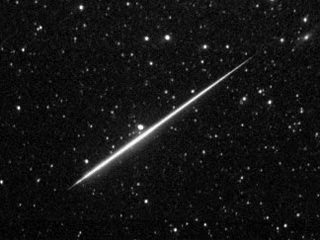On a typical clear night, I�ll spend anywhere from two to eight hours racing from one variable star field to another with the visual scope, under the protection of an observatory dome, or at the controls of my CCD telescope slewing and centering targets and watching images download on a computer screen from inside a warm room. I only see a small portion of the sky through the dome slot, eyepiece or on the monitor.
When a bright meteor flashes through the sky I rarely see it, unless I happen to be standing outside taking a break. I often don�t even know the weather is changing until the images in the eyepiece or on the screen start to deteriorate. Then I walk outside and look up to see if it�s a total wash out or just a passing cloud or two.
Now I find myself taking longer breaks from the telescope and spending some quiet time alone with the Universe. Just me and the night sky I fell in love with long ago. I�ve come to appreciate the simple majesty of those bright stars shining down on Earth just as they have for thousands of years. And over the course of the last year I�ve become familiar with several naked eye variables that I now keep track of.
I�ve followed an eclipse of Algol through the course of an evening. The first time I ever did it was at the AAVSO spring meeting in Nantucket, on the night we had the star party and tour of the Maria Mitchell Observatory. It was already halfway to minimum when I first noticed it, but I was able to follow it every half hour or so as it faded to minimum and then rose back to maximum. Clouds rolled in over the island in the early morning hours, so I didn�t get to see it back at full strength until the following night, but it made a lasting impression on me.
I�ve begun tracking the changes of delta and mu Cephei. Delta Cephei is the prototype of an entire class of astronomically significant variables. Cepheid variables are used to calibrate distances to far off stars and galaxies. Mu Cephei is also known as Herschel�s Garnet Star. It�s an orangish semi-regular variable that has been observed by variable star observers for over one hundred years.
As autumn approaches, the winter constellations are beginning to make their presence known again before dawn. I�ve spent a lot of time admiring the fiery bright winter constellations of Orion, Taurus, Gemini, and Auriga as they rise to fill the pre-dawn sky. I find myself fixing my gaze on eta Geminorum, Betelgeuse, Algol and epsilon Aurigae now, instead of racing from sideways �Y� of Taurus, through the Pleiades, up the curve of stars that is Perseus� lower branch through Auriga and on to Cassiopeia. Now I have little rest areas along the way.
 A calmness and sense of satisfaction comes over me when life slows down and fills these moments with the perfect silence that is 5 o�clock in the morning. The sound of a hoot owl in a nearby tree reminds me I am not alone, and we share the view as dawn begins to break in the east. Swiftly and silently, a meteor streaks across the sky and I smile to myself, because I didn�t miss that one.
A calmness and sense of satisfaction comes over me when life slows down and fills these moments with the perfect silence that is 5 o�clock in the morning. The sound of a hoot owl in a nearby tree reminds me I am not alone, and we share the view as dawn begins to break in the east. Swiftly and silently, a meteor streaks across the sky and I smile to myself, because I didn�t miss that one.

Tidak ada komentar:
Posting Komentar
Blog ini terbebas dari yang namanya CAPTHA. Jadi berkomentarlah dengan baik dan gunakan kata-kata yang sopan. Jangan SPAM, SARA, ataupun PORN.